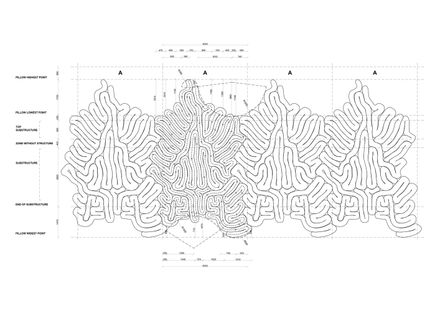
Weird Sensation Feels Good Exhibition at ArkDes
WEIRD SENSATION FEELS GOOD EXHIBITION AT ARKDES
Ēter
ARCHITECTS
Ēter
LEAD ARCHITECT
Ēter - Dagnija Smilga, Kārlis Bērziņš, Niklāvs Paegle
DESIGN TEAM
Dagnija Smilga, Kārlis Bērziņš, Niklāvs Paegle, Emīls Garančs
CLIENTS
ARKDES, The Swedish Centre for Architecture and Design
EXHIBITION PRDUCER
Halla Sigurðardóttir
GRAPHICS DESIGN
Irene Stracuzzi ✕ PostNew
EXHIBITION ARCHITECTURE
Dagnija Smilga, Kārlis Bērziņš, Niklāvs Paegle
CURATOR
James Taylor-Foster
PHOTOGRAPHS
Johan Dehlin
AREA
10 m²
YEAR
2020
LOCATION
Stockholm, Sweden
CATEGORY
Museums & Exhibit
Weird Sensation feels good is the first museum exhibition dedicated to ASMR (Autonomous Sensory Meridian Response).
It is, by extension, exploring emerging forms of wellness and tries to find ways to share this experience in a public setting (i.e. a museum).
The architecture of the exhibition is an attempt to synthesize the creative field of ASMR and its rich material world into a legible spatial language.
The exhibition seeks to bring both the body and mind to a state of comfort and higher sensitivity in order for visitors to experience tactile and audio-visual stimuli.
The most common experience of ASMR is privately, perhaps in a bedroom, where a person might feel most calm and protected. The exhibition design offers an acoustically-tempered environment, allowing guests to be immersed in a multisensory experience of close-looking, close-listening, and close-feeling.
Drawing inspiration from traditional spa cultures, flowing water is replaced by streams of contemporary media, aiming to create an atmosphere of safety and privacy in public, in which multiple people can be triggered to relax simultaneously.
In recent years an online audience of millions has grown, dedicated to watching the work of designers and content creators who try to trigger this feeling in their viewers. ASMR (Autonomous Sensory Meridian Response) is a term that describes a physical sensation: euphoria or deep calm, sometimes a tingling in the body.
As little as a decade ago, ASMR was largely dismissed as a figment of the imagination. Today the term represents one of the largest movements on the Internet, and it has become impossible to ignore.
As academic institutions around the world seek to make sense of the phenomenon, creatives—known as “ASMRtists”—are building on a cultural movement that transcends language and culture in favor of bodily ‘feels’.
The walls of the Boxen merge with the floor by way of soft folding biomorphic pillows. These pillows resemble the inner tissue of the body, the folds of the brain, audio cables, and erratic waveforms.
An important idea explored by the exhibition is the relationship between technology and the human body in material and tactile form – “the apparent sensitivity of technology” – which manifests itself in the architecture of the exhibition.
Video works are suspended from the ceiling as “TV chandeliers”, out of which gentle, silicone dipped hands reach out to serve headphones. Upon entering the exhibition, the floor of Boxen appears as if it has been melted. Guests take off their shoes and are invited to wear a bathrobe as they step onto the metallic ‘spill’.
Like meditation or yoga, ASMR happens to both your body and your mind. It is not about speed, but about focus and slowness. The double aisle set-up of the space allows for visitors to observe one another, creating a scene for live ASMR performances.
ASMRtists do not seek to entertain but to relax; for experiencers, it offers a degree of insulation from a noisy, wandering world. ASMR injects the Internet with softness, kindness, and empathy.
Through sound and film, shared through broadcasting platforms such as YouTube, works of ASMR make room for close-looking, close-listening, and close-feeling. While guests find the most comfortable spots to sit or lie on the soft aisles, ASMRtists become the new masters of the ceremony.
The exhibition, therefore, becomes a prototype for a new kind of public synthetic spa, offering an emergent form of relaxation and catering to the current collective concerns of the need to avoid physical touch and shared spaces.
Anecdotally, ASMR is being used as a form of self-medication against the effects of loneliness, insomnia, stress, and anxiety. This is a clue to its success, and to its transcendental appeal.
As a form of digital intimacy, it offers comfort on demand, standing against the feeling of isolation that constant connectivity can deceptively breed.
Step into an acoustically tuned environment and understand how people are deploying new and existing tools and materials to negotiate a complex world. It is the first exhibition of its kind to lift ASMR out from your screen and into public space.














